How to make an analysis of a selling landing page in 10 minutes and return 1000 buyers. Part 1
Let's start without preludes.
1) Measure the overall conversion of the landing page.
2) Measure the conversion of each target button on the page.
3) Find out the effectiveness of promotion channels in terms of conversion to purchase.
4) Make e-mail newsletters to those who have not completed the purchase.

To begin, we analyze the page: novogodnee-chudo.ru . There are 6 target buttons on it.

We need to connect to each button to collect data on clicks on them.
We have already installed the carrot quest service code on the site and are now launching the selectorGadget extension. Determine the selector of each button. Next, create an auto-event for clicking on each button. In the field "Did action" indicate the type of action "Click". In the CSS selector field, specify the selector of the desired button. We create 6 such auto events. After 2 minutes, we know who exactly clicked on each button. After clicking on any of the target buttons on the landing, a form appears with three steps to purchase a New Year's greetings.
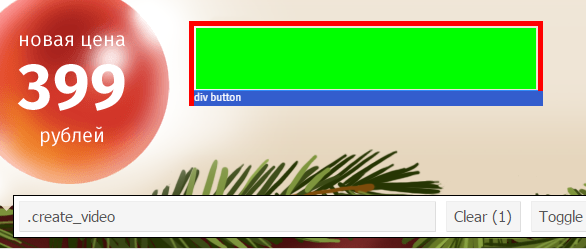

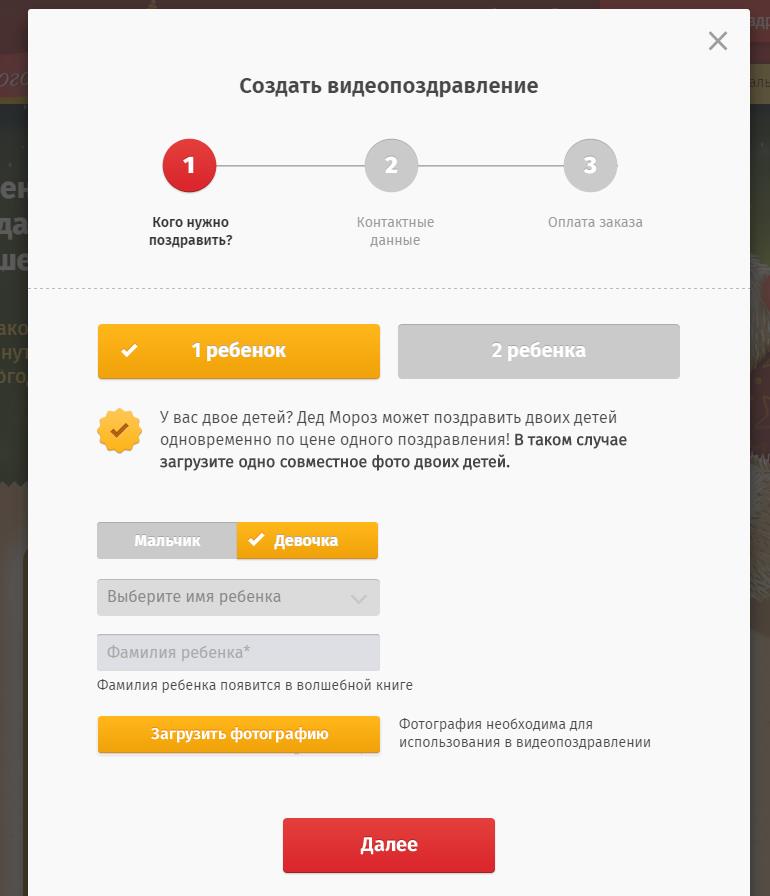
On the way we connect to the "Next" button. Similarly, we create an auto-event to track the click on this button.
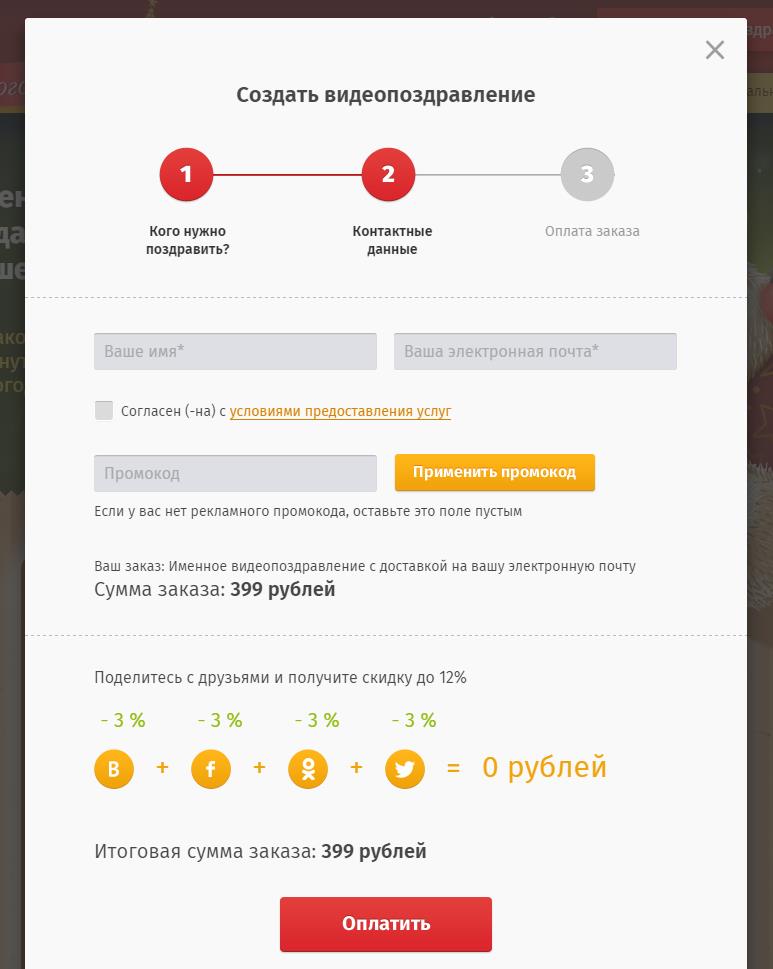
In the second step, fill in the customer’s name and email address.
We collect them using Auto Event "Fill in the input field." We start selectorgatget and we receive the selector of the field "your e-mail". Now what the user enters in this field is automatically recorded in the carrotquest service.
And we need this email to be recorded in the properties of this user for further e-mail distribution and communication with this user. Therefore, we indicate "Identify user" and in the additional properties enter $ email (this is our variable). Go ahead.
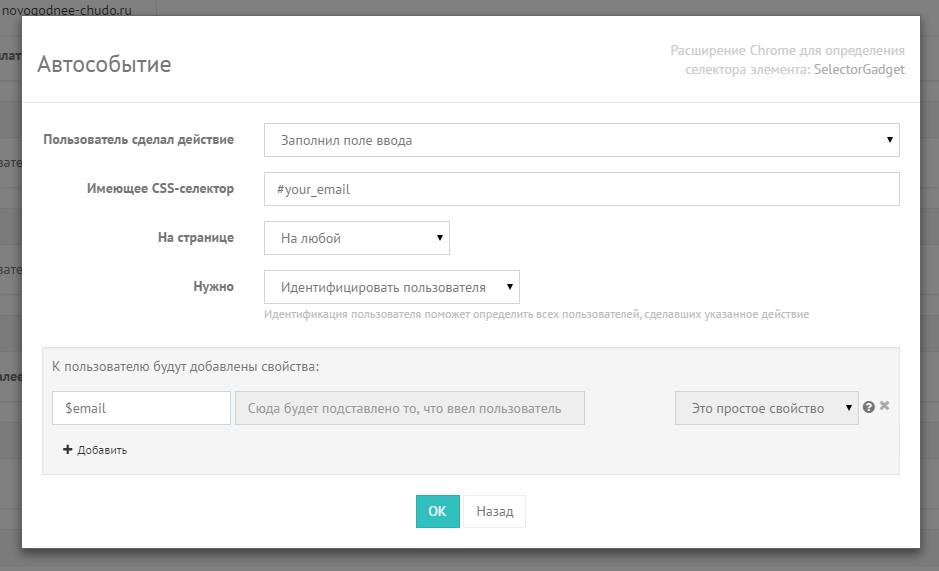
In the second step there is a button "Pay". We could get the click data for this button in exactly the same way as in step 1. Then we would know if the user clicked on it or not. But we need a little more - we need to know whether he switched to payment. Some users click on the "Pay" button without filling in the required fields. And that erodes the statistics. Therefore, we need exactly the transition to the payment page. Therefore, we will use the API and track not the click of a button, but the sending of data to the cash desk. Something like this:
The next step of the funnel is the success page. We track the hit on it very simply:
We make an auto-event of the type “went to the page” and indicate the address of the page. Actually this is all we had to do to configure it. We move on to the next part: analysis and marketing.
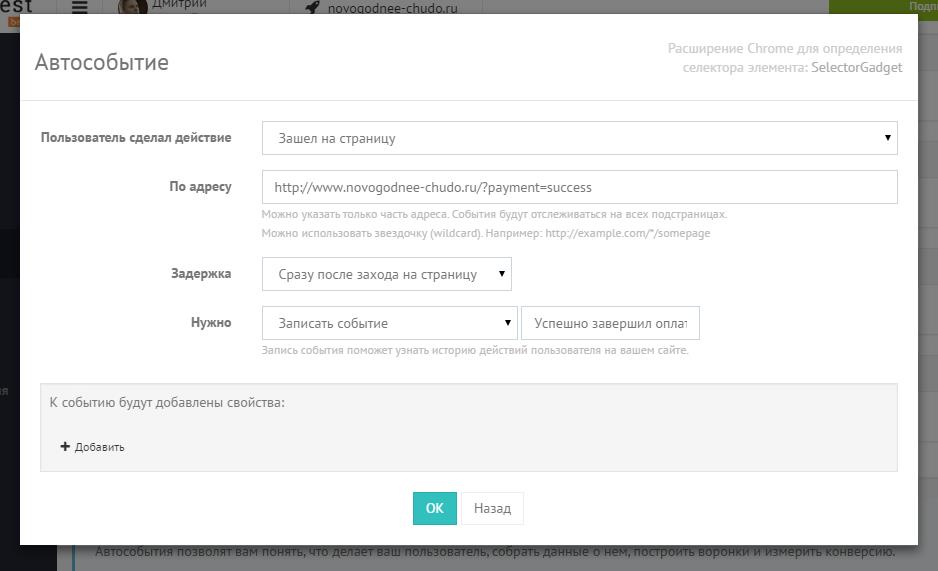
The task was to analyze the overall conversion of the landing page and see at what step the users “drop out” the most, and from which channels the largest conversion. For obvious reasons, we can’t show specific numbers, but here’s an approximate picture for the day:

In general, the transitions between 1, 2 steps and the transition to the payment page have a normal conversion. But at the payment step, quite a lot of users “fall off”. So e-mail marketing is relevant and it is worth trying to return these users. At least it’s worth asking why they didn’t pay. Maybe the problem is in the payment method?
Unfortunately, we also can’t show the promotion channels: ((You can tell the following: we saw from which channels the most traffic and conversion of each channel goes. We also looked at the effectiveness of advertising companies in the direct.
As a result, we found out that there are a couple of advertising companies in which it is pointless to invest money, and there are channels that give a large conversion. Budget allocation will instantly reduce costs and increase sales.
Here are the funnels for three of the six buttons: Even without exact numbers, it can be seen that the number of buyers from the top button is higher. And on the target button in the footer there are almost none. But this is not a completely correct comparison. It is clear that more visitors will click on the top button. Firstly, it is on the first screen. Secondly - she goes for the user. It is more interesting what kind of conversion is among those who clicked on the button and moved on to the second step. What happens next. What percentage of them turn into buyers. We look. No, a miracle did not happen. Of those who clicked on the top button, the percentage of those who paid more. Although it’s strange, because if you screwed it to the end of the page, you looked and more “activated”.
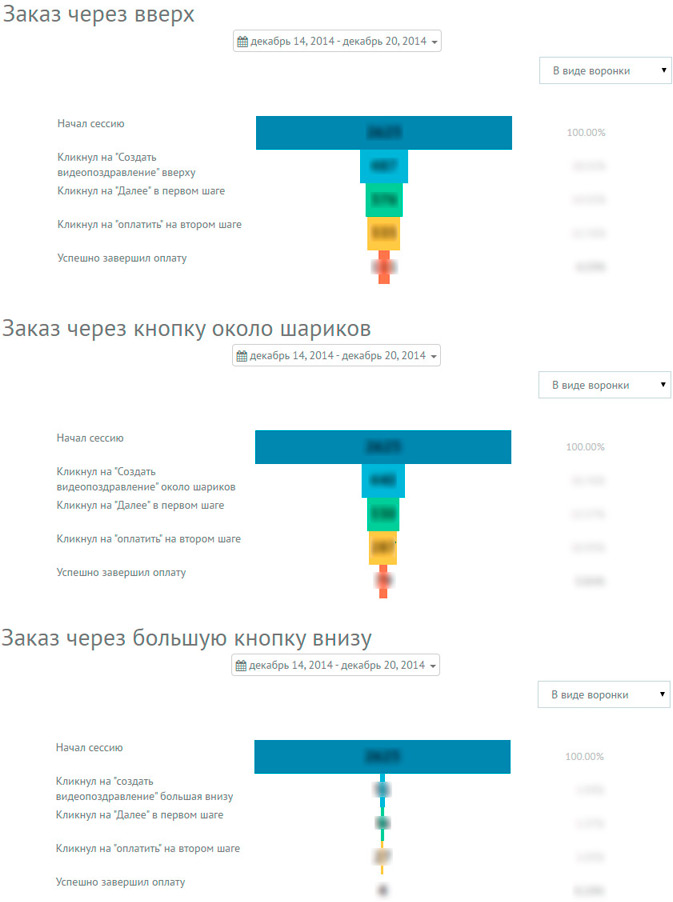

In general, we received interesting data for further analysis. You can do an AB test of the top button to increase the conversion of the transition to the second step.
You can change the content of the page for the channel, to increase the effectiveness of each channel.
But this is in the future. Let's move on to marketing.
Task: return the users who clicked the "Pay" button, but did not pay. They were ready to buy, but at the last moment something stopped them.
To get started, select a segment with these users. These are the users who clicked “Pay” in the second step, but did not get to the “Successful payment” page. We have already set up the tracking of all these events above. Having selected a segment with these users, we see that they are very um ... not a few. We cannot show the exact figure. We will only say that there are significantly more than 1000 of them.


Moreover, pay attention to the column "Sessions". Some of them were on the site more than once. The table below continues and there are users who came 3, 7, 10, 15, 99 times to the site, but they did not get to the "Payment Success" page. They definitely need to ask: what is the problem with payment?
To do this, we select either the entire segment or only the most active users and click "send e-mail".
Enter the text of the letter, depending on whether you want to return these users or ask what the problem is with the payment. This email has not yet been sent. But if at least 10% of those who did not buy return and complete the purchase, this will give + 2% to the total conversion. All this (tuning and data analysis) took about 10 minutes. This is 24 times less than writing the article itself (about 4 hours).

Total:
10 minutes of your time = plus 2% of your conversion.
Thank you for being with us. Cool products and better communication with users.
Ps
Here is a link to the event analytics service and conversion increase tools . For visitors from Habr we do a demo on Skype. Write in the chat.
Task
1) Measure the overall conversion of the landing page.
- How many visitors came;
- How many visitors filled out information about the child;
- How many visitors filled in information about themselves;
- How many visitors went to the page with payment;
- How many visitors completed the payment.
2) Measure the conversion of each target button on the page.
3) Find out the effectiveness of promotion channels in terms of conversion to purchase.
4) Make e-mail newsletters to those who have not completed the purchase.

Decision
To begin, we analyze the page: novogodnee-chudo.ru . There are 6 target buttons on it.

We need to connect to each button to collect data on clicks on them.
We have already installed the carrot quest service code on the site and are now launching the selectorGadget extension. Determine the selector of each button. Next, create an auto-event for clicking on each button. In the field "Did action" indicate the type of action "Click". In the CSS selector field, specify the selector of the desired button. We create 6 such auto events. After 2 minutes, we know who exactly clicked on each button. After clicking on any of the target buttons on the landing, a form appears with three steps to purchase a New Year's greetings.


Step 1 - Fill in the data of the child

On the way we connect to the "Next" button. Similarly, we create an auto-event to track the click on this button.
Step 2 - fill in the data about yourself

In the second step, fill in the customer’s name and email address.
We collect them using Auto Event "Fill in the input field." We start selectorgatget and we receive the selector of the field "your e-mail". Now what the user enters in this field is automatically recorded in the carrotquest service.
And we need this email to be recorded in the properties of this user for further e-mail distribution and communication with this user. Therefore, we indicate "Identify user" and in the additional properties enter $ email (this is our variable). Go ahead.

In the second step there is a button "Pay". We could get the click data for this button in exactly the same way as in step 1. Then we would know if the user clicked on it or not. But we need a little more - we need to know whether he switched to payment. Some users click on the "Pay" button without filling in the required fields. And that erodes the statistics. Therefore, we need exactly the transition to the payment page. Therefore, we will use the API and track not the click of a button, but the sending of data to the cash desk. Something like this:
carrotquest.track ('Event name', {param1: 'value1', param2: 'value2'});
The next step of the funnel is the success page. We track the hit on it very simply:
We make an auto-event of the type “went to the page” and indicate the address of the page. Actually this is all we had to do to configure it. We move on to the next part: analysis and marketing.

Funnel construction and channel analysis
The task was to analyze the overall conversion of the landing page and see at what step the users “drop out” the most, and from which channels the largest conversion. For obvious reasons, we can’t show specific numbers, but here’s an approximate picture for the day:

In general, the transitions between 1, 2 steps and the transition to the payment page have a normal conversion. But at the payment step, quite a lot of users “fall off”. So e-mail marketing is relevant and it is worth trying to return these users. At least it’s worth asking why they didn’t pay. Maybe the problem is in the payment method?
Unfortunately, we also can’t show the promotion channels: ((You can tell the following: we saw from which channels the most traffic and conversion of each channel goes. We also looked at the effectiveness of advertising companies in the direct.
As a result, we found out that there are a couple of advertising companies in which it is pointless to invest money, and there are channels that give a large conversion. Budget allocation will instantly reduce costs and increase sales.
Analysis of target buttons on the main page
Here are the funnels for three of the six buttons: Even without exact numbers, it can be seen that the number of buyers from the top button is higher. And on the target button in the footer there are almost none. But this is not a completely correct comparison. It is clear that more visitors will click on the top button. Firstly, it is on the first screen. Secondly - she goes for the user. It is more interesting what kind of conversion is among those who clicked on the button and moved on to the second step. What happens next. What percentage of them turn into buyers. We look. No, a miracle did not happen. Of those who clicked on the top button, the percentage of those who paid more. Although it’s strange, because if you screwed it to the end of the page, you looked and more “activated”.


In general, we received interesting data for further analysis. You can do an AB test of the top button to increase the conversion of the transition to the second step.
You can change the content of the page for the channel, to increase the effectiveness of each channel.
But this is in the future. Let's move on to marketing.
We select user segments and do e-mail marketing
Task: return the users who clicked the "Pay" button, but did not pay. They were ready to buy, but at the last moment something stopped them.
To get started, select a segment with these users. These are the users who clicked “Pay” in the second step, but did not get to the “Successful payment” page. We have already set up the tracking of all these events above. Having selected a segment with these users, we see that they are very um ... not a few. We cannot show the exact figure. We will only say that there are significantly more than 1000 of them.


Moreover, pay attention to the column "Sessions". Some of them were on the site more than once. The table below continues and there are users who came 3, 7, 10, 15, 99 times to the site, but they did not get to the "Payment Success" page. They definitely need to ask: what is the problem with payment?
To do this, we select either the entire segment or only the most active users and click "send e-mail".
Enter the text of the letter, depending on whether you want to return these users or ask what the problem is with the payment. This email has not yet been sent. But if at least 10% of those who did not buy return and complete the purchase, this will give + 2% to the total conversion. All this (tuning and data analysis) took about 10 minutes. This is 24 times less than writing the article itself (about 4 hours).

Total:
10 minutes of your time = plus 2% of your conversion.
Thank you for being with us. Cool products and better communication with users.
Ps
Here is a link to the event analytics service and conversion increase tools . For visitors from Habr we do a demo on Skype. Write in the chat.
